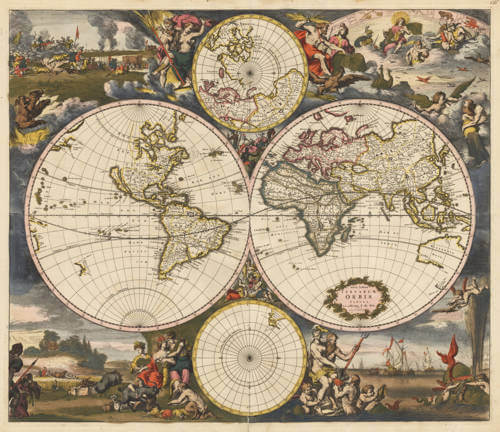Leen Helmink Antique Maps
Old books, maps and prints by Romeyn de Hooghe
Romeyn de Hooghe (1645-1708)
During his lifetime, the etcher Romeyn de Hooghe (Amsterdam 1645 – Haarlem 1708) was renowned as the most important graphic artist of its era. “Who wants to learn the art of etching, should become an apprentice of the very well educated Romeyn de Hooghe”Inleyding tot de hooge schoole der schilderkonst (Introduction to the academy of the art of painting).
This enthusiasm for the work of De Hooghe was still unchanged in the twentieth century. The famous Austrian art historian Otto Benesch considered Romeyn de Hooghe as “the most genius Dutch illustrator and one of the most important etcher of all times. His work united the universality of baroque, of which in Holland he was the last representative of European stature ...” [Otto Benesch, 1964, p. 368].
The versatility and high artistic quality are characteristic of the works of Romeyn de Hooghe. His illustrations and loose prints cover all possible subjects. De Hooghe illustrated books of every conceivable genre. In the area of loose prints, special attention is attracted to the numerous news prints, allegories, portraits, maps, topographical prints and costume prints. A good insight in his many-sided work is offered by the publications of Landwehr (1970 and 1972).
Romeyn de Hooghe also designed and etched numerous title pages of books. One of the oldest of his hand is the frontispiece of Nicolaas Witsen’s Aloude en Hedendaegsche Scheeps-Bouw en Bestier (1671). Witsen was the leading authority in the area of ship building and ship design in the late 17e century, and his profusely illustrated publications were famous internationally.
A remarkable aspect of the style of Romeyn de Hooghe is the extremely fluent and smooth manner of drawing and etching. The illustrations are filled with many human figures that suggest action: everywhere is activity and motion. Seen from a distance, the crowds have a shaping quality; a closer look reveals however a huge amount of narrative details. Especially striking are the facial and emotional expressions of the people who are depicted. In much of his work he combines often newly invented allegorical elements, inspired by classical antiquity and the Bible, with more concrete and contemporary representations. With his pictorial technique he tried to achieve emotional involvement from the spectator. This effective combination of erudition and inventiveness, of imagination and sensationalism, made his work irresistible for his contemporaries and has lost none of its charm today.
In addition to graphic art, Romeyn de Hooghe was closely involved in the design and manufacture of cartographic works. Notable examples are the large and decorative overview wall maps of Delft (1675-78), Haarlem (1688-89), Rotterdam (1694) and the Hoogheemraadschap (Water Board) of Rijnland (1687). These maps consist not only of a cartographic image, but are surrounded by city profiles, coat-ofarms of governors, decorations, separate title banners etc. Another famous example is the large portolan chart of
maritime cartography of the 17th century.
Romeyn de Hooghe rapidly developed himself to the most productive and the most popular etcher of his time, and he produced a great amount of prints for various purposes, from small book illustrations to luxury print series on large format. Despite all this, very little of his work has come to us in colour, especially in the form of his loose prints or loose charts.
Literature
Otto Benesch, Meisterzeichnungen der Albertina, Salzburg, 1964.
John Landwehr, Romeyn de Hooghe (1645-1708) as book-illustrator. A bibliography. Amsterdam, 1970.
John Landwehr, Romeyn de Hooghe the etcher. Contemporary portrayal of Europe 1662-1707. Leiden, 1972.
Georges Keyes (ed.), Mirror of Empire. Dutch marine art of the seventeenth century. Minneapolis: The Minneapolis Institute of Art, 1990.
Günter Schilder, A manuscript sea atlas, drawn by Romeyn de Hooghe in 1681. In: Publicacoes do Centro de Estudos de Cartografia Antiga. Vol. 130 (Coimbra 1981) 17 pp.
Günter Schilder, Dutch wall maps of the 16th, 17th and 18th Century. To be published, 2024.
Günter Schilder, personal communication.
Henk van Nierop et. al. (eds), Romeyn de Hooghe. De verbeelding van de late Gouden Eeuw. Zwolle: Waanders Uitgevers / Amsterdam: Bijzondere Collecties van de Universiteit van Amsterdam, 2008. Exhibition Catalogue.
Henk van Nierop, The Life of Romeyn de Hooghe 1645-1708. Amsterdam University Press, Amsterdam, 2018. Exhibition Catalogue.


